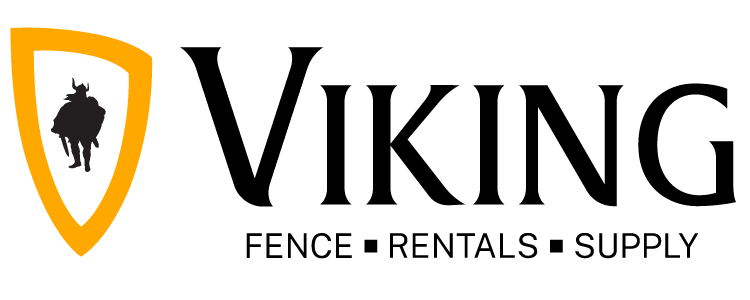
The significance of a robust temporary fencing solution cannot be overstated for those organizing events or setting up job sites. It’s the cornerstone of ensuring both safety and security in any dynamic environment.
You know you need a temporary fence, you just don’t know what approach to getting it set up best suits you. A DIY temporary fence offers a hands-on experience and can be a tempting route for those looking to save costs.
However, this route is not without its hurdles, from technical execution to time investment. Is tackling this project yourself the best course of action, or is it more prudent to leave it to seasoned professionals?
For those seeking assurance and expertise, Viking Rentals provides a worry-free solution, handling every aspect of temporary fencing, so you can direct your focus where it’s needed most in Texas. We’ve been the #1 choice for temporary fence rental in Dallas and beyond for decades.
We’ll cover the pros and cons of doing it yourself before offering tips on bringing your fencing vision to life. Then, we’ll show you why partnering with us is the best way to go!
What is a Temporary Fence For?
First things first – what is a temporary fence used for? It’s a critical component in various scenarios, offering a flexible and efficient solution to meet short-term needs.
Primarily, these fences are used to establish boundaries and secure areas temporarily for specific purposes. Here are some key use cases and benefits:
- Site Security: Temporary fencing is vital to secure construction sites, keeping unauthorized personnel out and protecting equipment from theft or vandalism.
- Crowd Control: During events like concerts, festivals, or sports games, these fences guide and manage the flow of people, ensuring safety and organized movement. It ensures a smooth event from start to finish.
- Privacy: Temporary fencing can provide privacy for exclusive events or conceal construction works from public view, maintaining a neat and professional appearance.
- Safety Measures: They act as a safety barrier, preventing access to hazardous areas or keeping pedestrians safe from construction activities.
- Regulatory Compliance: Temporary fencing is often required to comply with local laws, especially in public spaces or during construction projects.
- Environmental Protection: Fences can be used to protect landscapes and ecosystems from foot traffic or construction work, especially in sensitive areas.
The versatility of temporary fencing makes it an indispensable tool for various short-term applications, offering a balance of accessibility, security, and compliance.
The only question is, should you set up a DIY temporary fence or invest in a service provider to handle the heavy lifting for you?
Should You Set Up a DIY Temporary Fence?
Deciding whether to embark on a DIY temporary fencing project involves weighing both its benefits and challenges. This consideration is crucial for ensuring that your efforts align with your project’s needs and your capabilities.
Ultimately, though, you’re better off focusing your attention on areas you’re an expert in – just as we explained in our guide to the DIY portable hand washing station. Chances are, your strengths aren’t in planning and installing a temporary fence. But that is our expertise!
Nevertheless, here’s what you need to consider before deciding whether to install the temporary fencing yourself or not.
Benefits of DIY
One of the most appealing aspects of DIY fencing is saving on the temporary fence rental cost. You avoid labor costs associated with professional services by handling installation yourself. This can be especially beneficial for those on a tight budget or for smaller projects where the savings are significant.
That’s not all, though. DIY projects offer the freedom to customize, too. You can choose materials, designs, and layouts that perfectly fit the specific requirements of your site or event. This level of customization can often be hard to achieve with standard rental options.
You also enjoy more flexibility. You can start and complete the project according to your timeline, which is a considerable advantage for events or projects with a tight or unpredictable schedule.
Plus, building a temporary fence yourself can be a rewarding learning experience. It allows you to develop new skills and gain knowledge that could be useful for future projects.
There’s a sense of accomplishment in completing a project with your own hands. DIY temporary fencing can provide a fulfilling experience, particularly for those who enjoy hands-on work and tackling new challenges.
Challenges of DIY
Speaking of challenges, though, handling this project yourself is just that: a challenge. In fact, there are a number of reasons most individuals end up outsourcing the project altogether in the end. These include:
- Time and Effort: DIY projects demand a significant investment in terms of time and effort. For larger projects or more complex designs, the workload can be substantial and may require a steep learning curve.
- Quality and Durability: Professional fencing is designed to meet specific standards of quality and durability. Replicating this can be challenging, especially if you lack experience. There’s a risk that a DIY fence might not withstand weather conditions or the demands of the site.
- Tools and Equipment: Installing a fence requires specific tools and equipment. Acquiring these can be an additional expense and may be impractical if you don’t plan on using them again.
- Compliance Issues: Navigating local regulations and ensuring your fence meets all legal requirements can be complex. Mistakes in compliance can lead to fines or the need to redo the work.
- Safety Concerns: Without proper expertise, the installation process can pose safety risks. Incorrectly installed fences might be unstable and unsafe, posing a hazard to people on-site.
While DIY temporary fencing offers advantages like cost savings and customization, it also comes with challenges such as the need for specific tools, potential safety risks, and the time commitment required.
Balancing these factors is key in deciding whether a DIY approach is suitable for your needs. If you’re still committed to handling this on your own, we’ll share a few tips below to set you up for success.
Tips on Bringing Your DIY Temporary Fencing to Life
Whether you’re trying to learn how to barricade an event or you want advice on erecting a temporary fence for your construction site, here is some expert advice on bringing your DIY temporary fence to life – backed by more than 50 years at Viking Rental!
Planning Your Layout
Start by thoroughly assessing the area where the fence will be erected. Consider the terrain, existing structures, and any natural elements like trees or slopes. This assessment will guide the fence layout and help identify potential challenges.
Then, clarify whether the fence is for security, privacy, crowd control, or another purpose. This will influence the types of temporary fencing you choose, its height, and additional features like gates or privacy screens.
Create a rough sketch of the area and plan where the fence will go. Include all entry and exit points, and consider the flow of traffic, whether it’s people or vehicles.
Measure the perimeter to determine how much fencing material you will need. It’s always better to have a little extra than to run short. Ensure that your layout accommodates any accessibility requirements, such as emergency exits or paths for maintenance.
Before digging any holes or driving stakes, check for underground utilities to avoid costly and dangerous mistakes. You’ll also need to research local regulations to ensure your fence meets all legal requirements. Obtain any necessary permits before starting your project.
Essential Materials and Tools
What exactly do you need to set up a temporary fence DIY? It depends on your goal – as some fences need gates, while others require barbed wire. Here’s a general overview of the essentials:
- Fencing Panels or Rolls: Choose panels or rolls based on your fence type – chain link, wood, plastic, etc. Consider the ease of installation and the level of security each offers.
- Support Posts and Bases: Depending on the fence type, you may need support posts and bases to anchor the fence. Make sure they are sturdy and suitable for the ground type.
- Fasteners and Ties: You’ll need appropriate fasteners, like wire ties or clamps, to secure the panels or fencing material to the posts.
- Tools: Basic tools include a hammer, pliers, wire cutters, and a post-hole digger if you’re installing posts. A drill may be necessary for assembling certain types of panels.
- Safety Gear: Always use appropriate safety gear, including gloves, safety glasses, and sturdy footwear, to protect yourself during installation.
- Level and Tape Measure: A level ensures your fence lines are straight and even, while a tape measure is essential for accurate measurements.
- Marking Supplies: Use flags or spray paint to mark where posts or stakes will go, ensuring a consistent and even layout.
Step-by-Step Construction Guide
Now, let’s get into the fun part – actually piecing your materials together to make your fence vision a reality! Use your layout plan to mark the perimeter of where the fence will be installed. Place markers at regular intervals to indicate where posts or supports will be placed.
Clear the area along the marked line. Remove any debris, rocks, or vegetation that may obstruct installation. Then, you can into into the actual 5-step installation process:
- Install Posts or Supports: If using posts, dig holes to the recommended depth, typically around 24-30 inches, depending on the fence height. For freestanding panels or roll fencing, set up the bases or stands.
- Secure Posts or Panels: Place the posts in the holes and fill with concrete, ensuring they are level and straight. For panel fencing, connect the panels to the bases or stands, using fasteners as required.
- Attach Fencing Material: Roll out the fencing material along the posts, securing it with ties or staples at regular intervals. Ensure the material is taut and secure.
- Install Gates (if applicable): If your fence includes gates, install them at predetermined access points, ensuring they open and close smoothly.
- Final Check: Walk the fence line, checking for stability, gaps, or potential hazards. Make adjustments as needed for security and aesthetics.
DIY Temporary Fence Ideas
Before we wrap this guide up, we want to share some of the best DIY temporary fence ideas we’ve come across to offer inspiration if you’re unsure where to start:
- Classic Picket Fence: Perfect for events, a DIY picket fence adds charm and delineates areas without obstructing views. Use pre-made pickets and posts for easier assembly.
- Bamboo or Reed Fencing: Ideal for a natural look, bamboo or reed fencing rolls are easy to install and perfect for creating a relaxed, organic boundary.
- Wire and Wood Combo: For a sturdy and rustic fence, combine wire mesh with wooden posts. This design is especially suitable for areas needing extra security, like backyards or small construction sites.
- Recycled Pallet Fence: Environmentally friendly and cost-effective, pallets can be transformed into a unique and functional fence. Sand and paint them for a more polished look.
- Decorative Metal Panels: Metal fence panels with decorative patterns offer a modern and stylish solution. They’re excellent for events and venues where aesthetics are a priority.
- Vinyl Fencing: Easy to clean and maintain, vinyl fencing comes in various styles. It’s a great choice for both security and visual appeal.
- Portable Panel Fence: For the utmost in flexibility, create a fence with portable panels that can be easily assembled and disassembled. This is ideal for events that change locations frequently.
These DIY temporary fence ideas range from simple to sophisticated, offering solutions for various needs and aesthetic preferences. Each idea can be adapted and customized, allowing your DIY project to reflect your personal style and the specific requirements of your space.
Avoid the Hassle of DIY Temporary Fences With Viking Rental!
As you now know, the DIY temporary fencing project can be a daunting task, filled with challenges and unexpected hurdles. You can avoid all these and focus on what matters most by leaving it to Viking Rental!
We mentioned earlier we’re the #1 choice in Dallas, but you can also choose us for temporary fence rental in Austin, temporary fence rental in Houston, or temporary fence rental in Forth Worth. We bring five decades of experience to the table and a reputation for consistently exceeding our customers’ expectations.
We cater to a wide array of requirements, whether it’s for a bustling construction site or a high-energy event.
Our inventory boasts a variety of fencing options, from temporary chain link fence rental to temporary fence panel rental, security fence rental, temporary fence gate rentals, and more. Each solution is designed with the utmost attention to detail, ensuring it meets your exact specifications.
When you choose Viking Rentals, you’re choosing a comprehensive, hassle-free experience. We manage every aspect of the fencing process – from the initial consultation and site assessment to the installation, maintenance, and eventual removal of the fence.
Beyond our fencing, we have all the other rentals your event or project needs for smooth sailing. That includes the different types of porta potties, whether you need a traditional porta potty vs bathroom trailer. We also have all the different construction barricade types, from water to concrete. You’ll enjoy low barricade rental prices and portable toilet rental costs, too.
Our team of experts works diligently, ensuring that each fence is not only aesthetically pleasing but also secure and compliant with all local regulations. So, put the stress of a DIY temporary fence project in the past by contacting us today!
Closing Thoughts on DIY Temporary Fencing
DIY temporary fencing offers a unique blend of cost-effectiveness, customization, and the satisfaction of hands-on work. It’s an excellent choice for those who have the time, skills, and desire to tackle such projects.
However, it’s important to consider the challenges, including the effort, tools required, and potential compliance issues. For those seeking convenience and professional assurance, Viking Rentals is your go-to solution.
Learn more about ADA portable toilet dimensions, portable hand washing station rental cost, where to rent a fence, bathroom trailer rental prices, and more in our blog. Otherwise, it’s time to get in touch with Viking Rental for your temporary fence.
We provide expertly installed, high-quality temporary fencing tailored to your specific needs, allowing you to focus on the bigger picture of your event or project. Connect with Viking Rentals today and experience stress-free fencing solutions!

